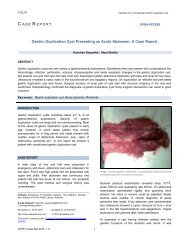pdf version - APSP Journal of Case Reports
pdf version - APSP Journal of Case Reports
pdf version - APSP Journal of Case Reports
Create successful ePaper yourself
Turn your PDF publications into a flip-book with our unique Google optimized e-Paper software.
Batool, Hyposkillia and critical thinking<br />
L E T T E R T O T H E E D I T O R<br />
OPEN ACCESS<br />
Hyposkillia and Critical Thinking: Lost Skills <strong>of</strong> Doctors<br />
Tayyaba Batool<br />
Dear Sir,<br />
Imperforate hymen is the most frequent obstructive<br />
anomaly <strong>of</strong> the female genital tract. It can be diagnosed<br />
on prenatal ultrasound as bladder outlet obstruction, due<br />
to hydrocolpos or mucocolpos 1 and postnatally on<br />
physical examination <strong>of</strong> the perineum and abdomen. No<br />
additional tests or investigative tools are required for<br />
diagnosis per se. We share our experience <strong>of</strong> two index<br />
cases <strong>of</strong> imperforate hymen where clinical diagnosis was<br />
missed.<br />
<strong>Case</strong> 1: A 21-day-old female baby was presented with<br />
complaint <strong>of</strong> urinary retention. Since bladder was<br />
palpable on examination, catheterization was done by the<br />
nursing staff on advice <strong>of</strong> a resident. Urinalysis and<br />
ultrasound were advised which turned out to be<br />
insignificant. On 5th day <strong>of</strong> admission it was noticed that<br />
despite catheterization lower abdomen was still<br />
distended. Perineal examination done at that time<br />
revealed imperforate hymen [Image 1].<br />
Image 1: A neonate with imperforate hymen - An<br />
obvious clinical finding not to be missed.<br />
<strong>Case</strong> 2: Twelve years old female presented with lower<br />
abdominal mass. She was catheterized elsewhere for<br />
urinary retention but mass persisted. She was admitted<br />
and CT scan abdomen advised which picked up a cystic<br />
mass in pelvis [Image 2]. Surgery planned and on<br />
operation table perineal examination revealed an obvious<br />
bulge at vaginal orifice.<br />
Hymenotomy was performed in both the cases.<br />
Critical thinking is about how we approach to the<br />
problems, questions and issues. 2 Learning clinical skills is<br />
an art and critical thinking is part and parcel to acquire<br />
this art.<br />
Hyposkilliacs are “physicians who cannot take an<br />
adequate medical history, cannot perform a reliable<br />
physical examination, cannot critically assess the<br />
information they gather, cannot create a sound<br />
management plan, have little reasoning power, and<br />
communicate poorly. They learn to order all kinds <strong>of</strong> tests<br />
and procedures but don't always know when to order<br />
[them] or how to interpret them” 3<br />
<strong>APSP</strong> J <strong>Case</strong> Rep 2010; 1: 9 1<br />
Image 2: CT scan showing distended vagina and<br />
displaced urinary bladder.<br />
The requisite <strong>of</strong> producing good clinicians is to create an<br />
environment <strong>of</strong> inquiry. The learner or clinician will<br />
analyze and evaluate the patient and disease with his/her<br />
cognitive skills only if his brain is primed to do so.<br />
Otherwise the culture <strong>of</strong> technological overuse will keep<br />
on flourishing; and we will end up in producing clinicians<br />
unable to pick up simple clinical diagnoses with poor<br />
basic knowledge and skills. This is high time to revisit the
Batool, Hyposkillia and critical thinking<br />
training methods for junior doctors, to be addressed<br />
conscientiously.<br />
REFERENCES<br />
1. Hillard PJA, e- medicine, Imperforate Hymen,<br />
Department <strong>of</strong> Gynae/Obs, Stanford University<br />
Medical Centre: Updated Feb 24, 2010. Accessed on<br />
June 13, 2010. Available from;<br />
http://emedicine.medscape.com/article/269050-<br />
oveview<br />
2. Facione PA. Critical Thinking: What it is and why it<br />
counts? 2010 update. Insight assessment. Millbrae,<br />
CA: The California Academic Press. 2010 Available<br />
from;<br />
http://www.insightassessment.com/<strong>pdf</strong>_files/what&w<br />
hy2006.<strong>pdf</strong><br />
3. Fred HL. Hyposkillia – Deficiency <strong>of</strong> Clinical Skills.<br />
Tex Heart Inst J. 2005; 32: 255-7.<br />
Tayyaba Batool<br />
Address: Department <strong>of</strong> Paediatric Surgery,<br />
National Institute <strong>of</strong> Child Health Karachi, Pakistan.<br />
Email: docnich2003@yahoo.com<br />
Received on: 10-06-2010 Accepted on: 06-07-2010<br />
http://www.apspjcaserep.com<br />
© 2010 Batool<br />
This work is licensed under a Creative Commons Attribution 3.0<br />
Unported License<br />
How to cite<br />
Batool T. Hyposkillia and critical thinking: Lost skills <strong>of</strong> doctors. <strong>APSP</strong> J <strong>Case</strong> Rep 2010; 1: 9<br />
<strong>APSP</strong> J <strong>Case</strong> Rep 2010; 1: 9 2











